Ca2+ -activated Cl- channels (TMEM16A) underlie spontaneous electrical activity in isolated mouse corpus cavernosum smooth muscle cells
- PMID: 36394209
- PMCID: PMC9669617
- DOI: 10.14814/phy2.15504
Ca2+ -activated Cl- channels (TMEM16A) underlie spontaneous electrical activity in isolated mouse corpus cavernosum smooth muscle cells
Abstract
Penile detumescence is maintained by tonic contraction of corpus cavernosum smooth muscle cells (CCSMC), but the underlying mechanisms have not been fully elucidated. The purpose of this study was to characterize the mechanisms underlying activation of TMEM16A Ca2+ -activated Cl- channels in freshly isolated murine CCSMC. Male C57BL/6 mice aged 10-18 weeks were euthanized via intraperitoneal injection of sodium pentobarbital (100 mg.kg-1 ). Whole-cell patch clamp, pharmacological, and immunocytochemical experiments were performed on isolated CCSM. Tension measurements were performed in whole tissue. TMEM16A expression in murine corpus cavernosum was confirmed using immunocytochemistry. Isolated CCSMC developed spontaneous transient inward currents (STICs) under voltage clamp and spontaneous transient depolarizations (STDs) in current clamp mode of the whole cell, perforated patch clamp technique. STICs reversed close to the predicted Cl- equilibrium potential and both STICs and STDs were blocked by the TMEM16A channel blockers, Ani9 and CaCC(inh)-A01. These events were also blocked by GSK7975A (ORAI inhibitor), cyclopiazonic acid (CPA, sarcoplasmic reticulum [SR] Ca2+- ATPase blocker), tetracaine (RyR blocker), and 2APB (IP3 R blocker), suggesting that they were dependent on Ca2+ release from intracellular Ca2+ stores. Nifedipine (L-type Ca2+ channel blocker) did not affect STICs, but reduced the duration of STDs. Phenylephrine induced transient depolarizations and transient inward currents which were blocked by Ani9. Similarly, phenylephrine induced phasic contractions of intact corpus cavernosum muscle strips and these events were also inhibited by Ani9. This study suggests that contraction of CCSM is regulated by activation of TMEM16A channels and therefore inhibition of these channels could lead to penile erection.
© 2022 The Authors. Physiological Reports published by Wiley Periodicals LLC on behalf of The Physiological Society and the American Physiological Society.
Conflict of interest statement
No conflicts of interest, financial or otherwise, are declared by the authors.
Figures


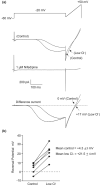
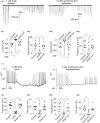
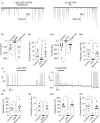
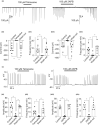
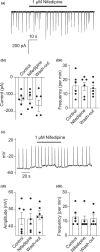
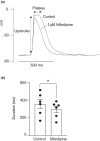
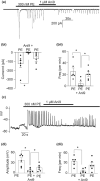

Similar articles
-
KV7 channels modulate tension and calcium signaling in mouse corpus cavernosum.Am J Physiol Cell Physiol. 2025 Mar 1;328(3):C729-C742. doi: 10.1152/ajpcell.00980.2024. Epub 2025 Jan 19. Am J Physiol Cell Physiol. 2025. PMID: 39828508
-
Effects of phenylephrine on spontaneous activity and L-type Ca2+ current in isolated corpus cavernosum myocytes.J Sex Med. 2012 Nov;9(11):2795-805. doi: 10.1111/j.1743-6109.2012.02847.x. Epub 2012 Jul 12. J Sex Med. 2012. PMID: 22788218
-
Fast voltage-dependent sodium (NaV ) currents are functionally expressed in mouse corpus cavernosum smooth muscle cells.Br J Pharmacol. 2022 Mar;179(5):1082-1101. doi: 10.1111/bph.15728. Epub 2021 Dec 16. Br J Pharmacol. 2022. PMID: 34767251
-
Ion Channels and Intracellular Calcium Signalling in Corpus Cavernosum.Adv Exp Med Biol. 2019;1124:171-194. doi: 10.1007/978-981-13-5895-1_7. Adv Exp Med Biol. 2019. PMID: 31183827 Review.
-
Interstitial cells of Cajal in the urethra.J Cell Mol Med. 2006 Apr-Jun;10(2):280-91. doi: 10.1111/j.1582-4934.2006.tb00399.x. J Cell Mol Med. 2006. PMID: 16796799 Free PMC article. Review.
Cited by
-
Involvement of ANO1 currents in pacemaking of PDGFRα-positive specialised smooth muscle cells in rat caudal epididymis.Cell Tissue Res. 2024 Jul;397(1):1-12. doi: 10.1007/s00441-024-03890-x. Epub 2024 Apr 8. Cell Tissue Res. 2024. PMID: 38587529
-
ANO1 channels are expressed in mouse urethral smooth muscle but do not contribute to agonist or neurally evoked contractions.Sci Rep. 2025 May 19;15(1):17365. doi: 10.1038/s41598-025-00953-z. Sci Rep. 2025. PMID: 40389459 Free PMC article.
References
-
- Andersson, K. E. , & Wagner, G. (1995). Physiology of penile erection. Physiological Reviews, 75(1), 191–236. - PubMed
-
- Bradley, E. , Hollywood, M. A. , McHale, N. G. , Thornbury, K. D. , & Sergeant, G. P. (2005). Pacemaker activity in urethral interstitial cells is not dependent on capacitative calcium entry. American Journal of Physiology‐Cell Physiology, 289(3), C625–C632. - PubMed
-
- Burnett, A. L. (2006). Erectile dysfunction. The Journal of Urology, 175(3 Pt 2), S25–S31. - PubMed
-
- Caputo, A. , Caci, E. , Ferrera, L. , Pedemonte, N. , Barsanti, C. , Sondo, E. , Pfeffer, U. , Ravazzolo, R. , Zegarra‐Moran, O. , & Galietta, L. J. (2008). TMEM16A, a membrane protein associated with calcium‐dependent chloride channel activity. Science, 322(5901), 590–594. - PubMed
Publication types
MeSH terms
Substances
LinkOut - more resources
Full Text Sources
Medical
Research Materials
Miscellaneous

